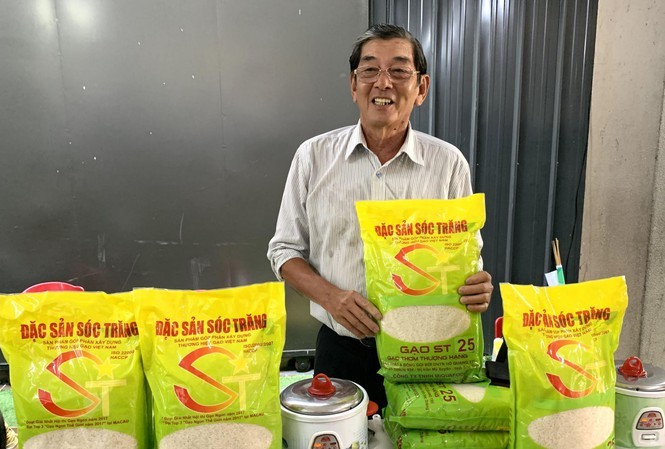(VOVWORLD) - After trying for more than 25 years, agricultural engineer Ho Quang Cua and his colleagues successfully cross-bred Vietnam's ST25 rice, named the world's best rice in last year’s ranking. The "father" of ST25 rice recently told reporters about his relentless effort to bring Vietnamese rice to the top position and his concerns about how to maintain this achievement.
|
 Agricultural engineer Ho Quang Cua and cross-bred Vietnam's ST25 rice Agricultural engineer Ho Quang Cua and cross-bred Vietnam's ST25 rice
(Photo: baogiaothong.vn)
|
Ho Quang Cua remembers the year 1991 when he began researching premium fragrant rice ST25. At that time, as a farmer-scientist, he and his colleagues were determined to restore the once famous rice variety of Soc Trang province.
“We had to traverse a long road of 25 years to reach the title ‘the world’s best rice’. Soc Trang had begun to export its best rice, ST, to Europe in the early 20th century but it faded. Our aspiration was to restore its position as the most delicious rice variety,” Cua recalls.
After two and a half decades of tireless efforts, the ST rice strain made the top three for three consecutive years in 2017, 2018, and 2019. Last year it was honored as the world’s best rice.
Cua said: “We have improved the rice strain by from our own experience and the experience of people in other areas. In 2017 we began to near our target, to make this high-yield, short-term rice strain of Southeast Asia the world’s top rice. The rice strains which have previously won were low-yield tenth-month or winter crop rice with less potential to dominate the market.”
ST25 rice is a long grain rice, clear, not silver. It has a sweet, aromatic, hint of pineapple flavor and absorbs less water than other rice varieties.
Cua said he was surprised when ST25 rice recently became much sought after in the domestic market because, for a long time, Vietnamese customers have preferred rice strains imported from Cambodia and Thailand.
“The change proves that Vietnamese people have strong national pride and want to buy made-in-Vietnam products. In the past, it was that domestic products hadn’t yet won their trust,” said Cua, adding he is proud of his achievements, but also worried about maintaining the delicious rice variety and passing it onto future generations. These concerns have gotten the attention of government agencies.
Cua said linking farmers, the State, scientists, and businesses will be the key to the problem: “As scientists, we’ll do our best to maintain the quality of this rice strain for future generations. But there is only so much we can do. That’s why it’s necessary to involve other sectors of society to develop and maintain Vietnam’s best rice strain.”